A bus ride from Srinigar, Kashmir, to Leh takes two days, but it felt like a lot longer given the cramped seat space. The road, which was hastily completed after the Indo-Chinese War in 1962, climbs over three passes of approx. 5,000 meters. It was only open from late spring to early fall. There was also another road, which does not go through Kashmir, but it was restricted to the military at that time. The road was one-way: traffic in the direction of Ladakh in the morning and in the direction of Kashmir in the afternoon. Unfortunately, not all vehicles observed this regulation, and it was not uncommon to encounter a bus or truck headed in the opposite direction just when we arrived at a tricky curve on the side of some mountain with a drop of several hundred meters several centimeters to the right of the bus.

The bus stopped for the night at Kargil, which is very close to the Pakistani side of Kashmir. Only a few short years later, I would read about fighting between India and Pakistan, the Kargil War, when Pakistan invaded the area. Kargil is the last Muslim village before the Buddhist area of Ladakh starts, and older references to it highlighted its propensity of fleas and flies, which had not changed.
Another long day’s bus ride, and when we finally arrived in Leh, which is at an altitude of 3,500 meters and meant we need a few days to acclimatize. When got off the bus, a young Ladakhi asked us if we wanted a room. The touts in Kashmir had been extremely annoying, so much so that we could not look sideways without someone trying to pull us into his shop or restaurant. As a result, we immediately said no, but the guy then went away instead of continuing to pester us as happened in Kashmir. “Wait! We do want a room.” But it was too late; he was already gone, and we had to spend an hour trudging around trying to find accommodation.

Beautiful guest house in Leh
We finally found a room, but had to share it with two others the first night. The floor was made of dried mud and rather dusty, and soon we all moved out onto the terrace to sleep in the open (as many Ladakhis do in the summer). Due to the extremely low humidity and altitude, the sky is extremely clear and the stars bright. I fell asleep gazing at the right heavens and the towering Zanskar range of mountains ascending to 7,000 meters across the valley.
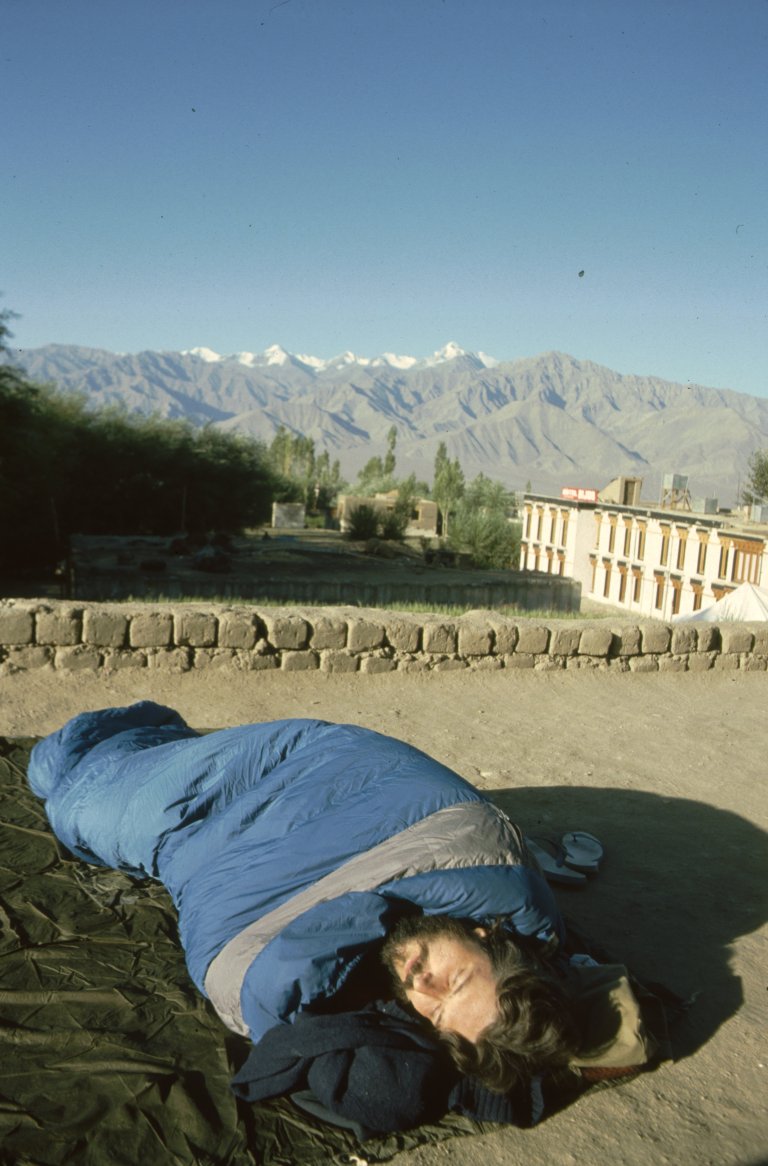
The first few days, we were content ambling through the streets. There was much to see in this capital of then 8,000 inhabitants (I read that there are now 30,000). The Ladakhis have beautiful, handcrafted native dress, which most still wore at the time. The women had turned-up hats, which reminded me of traditional Dutch ones. They also had vests and jackets of velvet and silk. The men wore long woolen coats, and many had long, braided hair (which the women also had).

The eldest daughter in a family inherits the “perak”. This is a hat consisting of a leather band studded with turquoise, and it has a flat gold or silver box, called a “kagu”, with protecting prayers on it. It was often worth twenty to thirty thousand dollars at the time. Traditionally, women constantly wore their perkas, especially when they were working in the fields, in case bandits came to their village. As a result, they did not have to gather their valuables before they fled.


The women also wore necklaces made of turquoise, coral, pearls and amber. The Himalaya are relatively young mountains and were under the sea not that long ago, which explains the coral and pearls.
Towering about the town is the king’s palace, modeled after the Potala in Tibet. The king was forced to evacuate it in 1840 and moved across the valley to the Palace of Stok. When we visited, there was no king but a queen, a widow, Rani from Stock, who lived in the Place of Stok and also represented Ladakh in the Indian parliament.
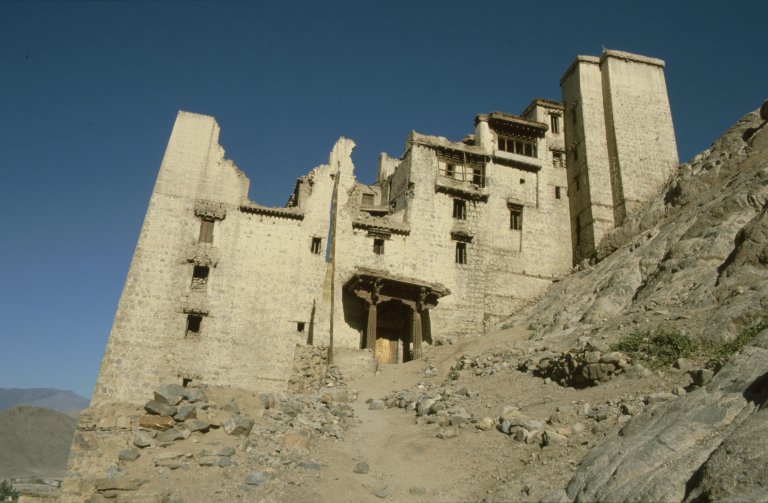
The king’s palace is pretty much in ruins, and the tourist office told us that we could not visit it. We took a walk up there anyway, and a monk was waiting at the entrance who showed us the two rooms for a few rupees when you can still safely tread.
From there, we continued up the hill to a small Buddhist temple. The monk in charge was away and consequently it was closed, but the view was magnificent. The rooftops of Leh were far below with their many tents where the inhabitants slept.

The beautiful, irrigated green barley fields came to abrupt ends where the barren hillsides began.
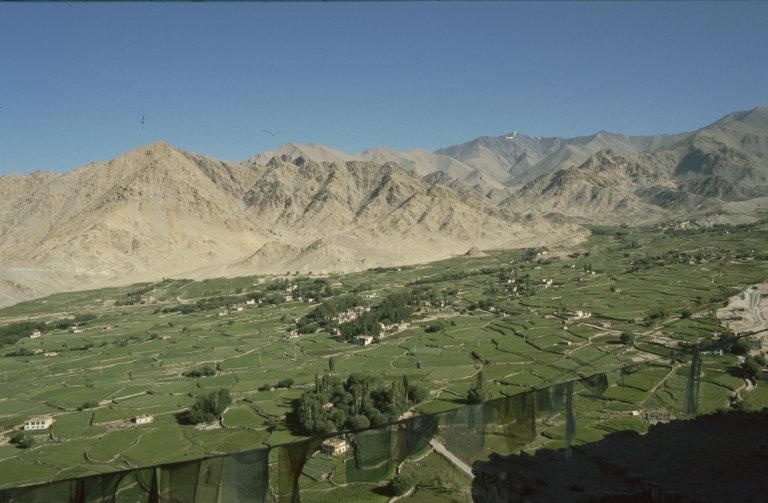
We could see snow on distant mountains despite the tremendous heat of the day.

And sprinkled across the countryside were innumerable “chortens”, religious structures models after Indian stupas. They contain relics of Buddha or the ashes of a holy man or a high-placed lama.
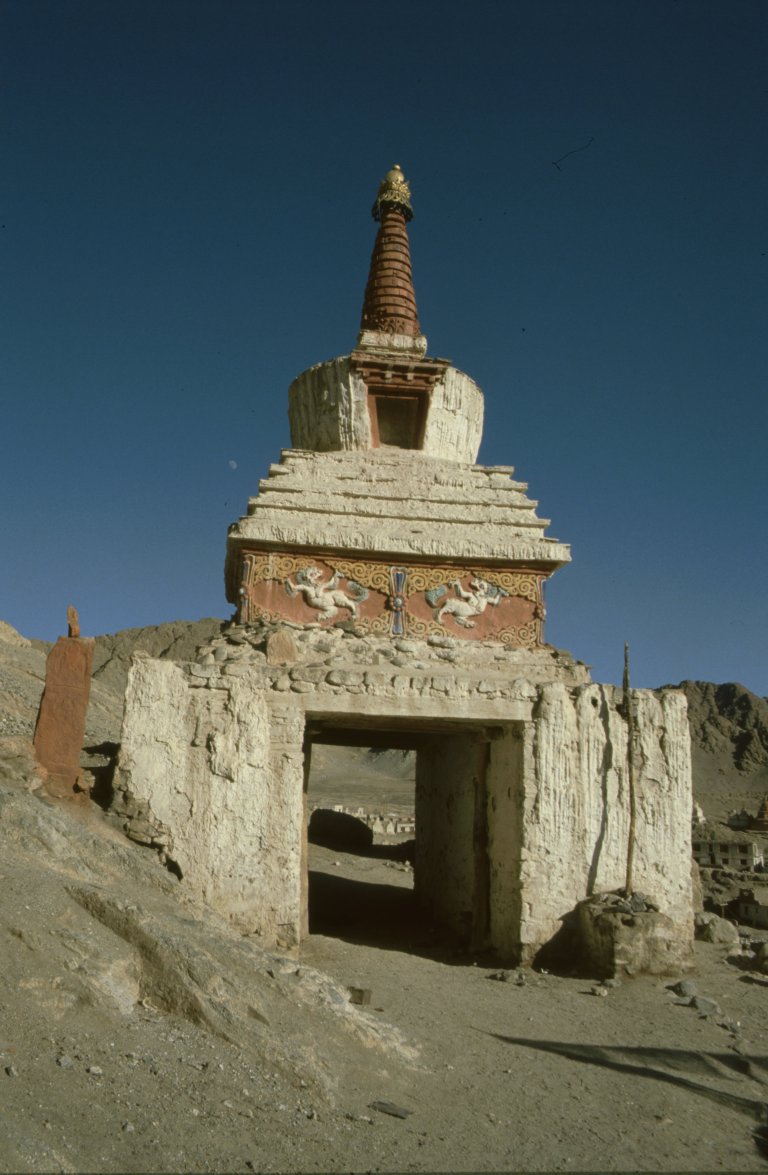
There was a festival planned in Leh organized by the tourist office. Festivals are normally held in winter when there is no work to be done in the fields, but no tourists either. There was a polo tournament, an archery contest (with lots of laughing, since apparently archery was not practiced much anymore and most arrows went wide of their target), dancing and music by different tribes.

Some of the tribes are rarely seen in Leh, and they were almost as foreign to the inhabitants of Leh as to us. The Dropkas were the most striking example of this. They rarely come to Leh and live in an area close to the Pakistani border, which is off-limits to all except the military. These former nomads are of Aryan ancestry, and their facial features form a stark contrast to the Oriental features of the other Ladakhis. Many of them had blue eyes, and they were said to be descendants of Alexander the Great’s army that had invaded the area thousands of years ago. They are Buddhists, but also believe in animism. One of their most astounding features is their deep-seated revulsion of cows and everything connected with them (leather, cow milk, etc.).

The Dropkas were dressed in extremely thick wool clothing despite the heat. Perhaps it served to preserve their body moisture, but in the afternoon it was too hot for me to even stand in the sun.

Descendants of Alexander the Great’s army?
Local groups seemed to be having a lot fun, a lot more than many camera-toting tourists who seemed bored once they had taken their full of pictures.


Of course, a band was there to accompany the dances.

There was a Tibetan refugee camp 13 kilometers from Leh at Choglansan. They were also represented with a dance troupe, and their dances were quite different from the others, since they were rather fast. Their facial features are also a lot more Oriental than that of most Ladakhis. They staged a very amusing yak dance with two men dressed as a yak and in another dance as a lion (?).


The highlight at the end of our trip was a 10-day trek from Lamaruyu Monastery to the Kingdom of Zaskar, traversing five passes higher than 5,000 meters. However, getting to Lamaruyu proved to be more difficult than we had expected, since it rained the night before we wanted to go and consequently there were landslides that were blocking the road. Since we had limited time, we arranged a taxi to take us there with a stop at Alchi, one of the most famous monasteries in Leh. It was founded in the 11th century, but what makes it famous are its carvings and frescoes.
Alchi Monastery
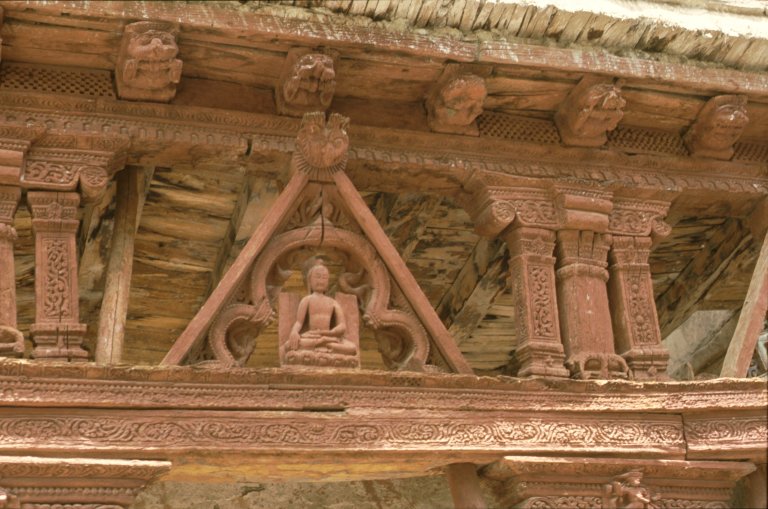
Lamayuru Monastery

After visiting Lamayuru Monastery, we proceeded to make arrangements for a 10-day trek to Zanskar. Two middle-aged Germans arrived who had hiked in the opposite direction and had hired a Zanskari as a guide with two donkeys for carrying their packs. They recommended him highly, but said, “He can’t add two and two, but he’s very honest and dependable.”
As it turned out, Raftan was a very intelligent man who knew the ways of his world very well, a lot better than some of the other guides we encountered or heard about. He was literate and never failed to take out his prayer book mornings and evenings.
Lamayuru was supposed to get electricity the following year. There was one “store” that had practically nothing for sale. Raftan could not even buy tsampa there, ground barley which is a staple of Ladakhis’ (and Tibetans’) diet. Our hotel had not water, and the toilet had caved in. When I asked about a substitute, I was pointed to an abandoned house, but it was filled with excrement. In our room there, the garbage was neatly swept into a corner. We removed the seedy-looking mattresses from the cots before going to bed. Then we covered them with our ponchos to keep the famous fleas and bedbugs of Ladakh at bay.
Before we left, we talked to some people who had come from Kargil by walking over the damaged part of the road. They told us that a bridge on the road from Kargil to Padum—our return route—had also been washed out.
There were two other Americans, with whom we hired Raftan and his donkeys. We had run into Dave and Jill frequently in Leh and again in Lamayuru. They seemed very friendly, and we thought we had become very close to them during our 10-trek to Zanskar. However, when we visited them two years later in Boston, I noticed looks they were giving each other when they thought I was not looking, looks that clearly displayed their annoyance at our visit and hopes that we would soon leave. How poorly we had understood them! And I had thought these were close friends, with whom I would stay in contact for years. We only heard from them once or twice after that.
With enough food (but just enough) and our trekking gear, we took off early in the morning. The first pass came soon and was the easiest. There are five passes of approx. 5,000 meters that we would cross on our 10-day, 200-kilometer trek. The lowest altitude was 3, 980 meters and highest pass 5,120 meters.
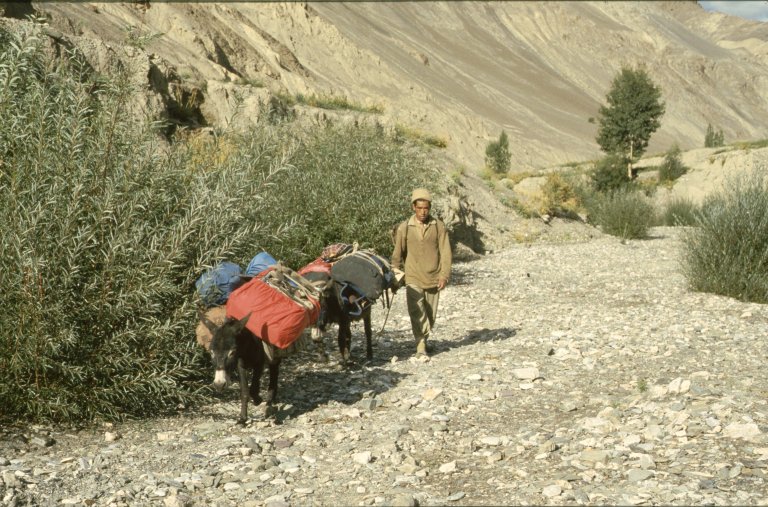
Raftan with our packs and his donkeys
We stopped at the first village, Wanla, next to a river, and Raftan made tea. There was a barley mill in a small edifice where barley dropped from a funnel onto a round stone turned by water flowing underneath. The smell of freshly ground barley was more than delicious.

We thought we would stay in Wanla the first night, but we were there at noon, and Raftan pressed for us to continue. We headed down a valley with a surging river in its middle and towering mountains in the distance. One farmer offered to sell us apricots. We could not refuse, since they were delicious, but his children knocked down more from a tree than we could carry. They became easily bruised while we were walking, and so we had to stew what we had left the next morning. However, they were a great addition to tsampa.
The valley soon became narrower, and we found ourselves on a very narrow path. At one point, we crossed a long section of small, loose rocks and dreaded thinking what it would be like in the rain. We were sure that the donkey could not make it with the packs, and we waited for Raftan to help him. That turned out to be totally unnecessary, since the donkeys crossed the stretch more easily than we had.


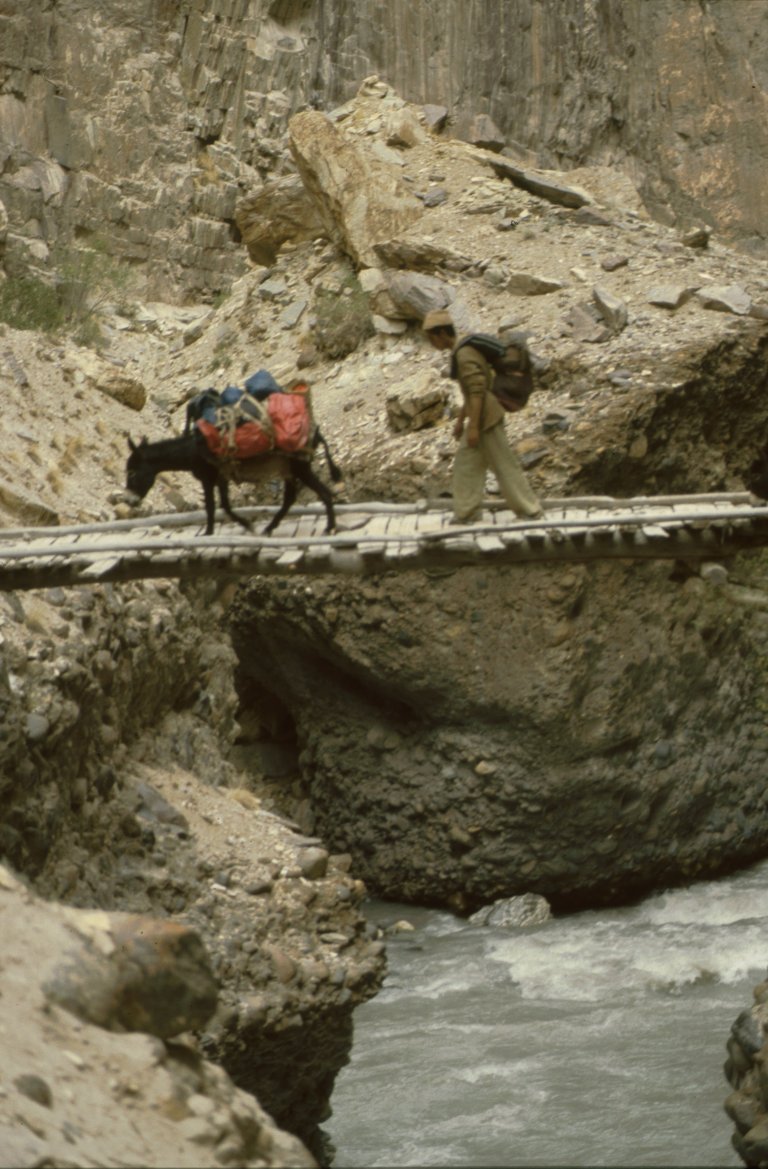
The landscape looked like what I imagined the moonscape to be.

Moon-like landscape on the trek from Ladakh to Zanskar
We passed small hamlets and fields being cultivated as well as an occasional herd of goats.
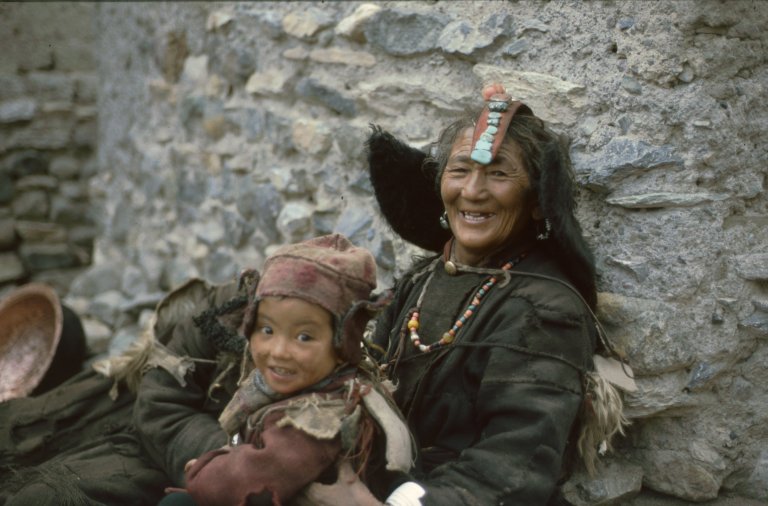

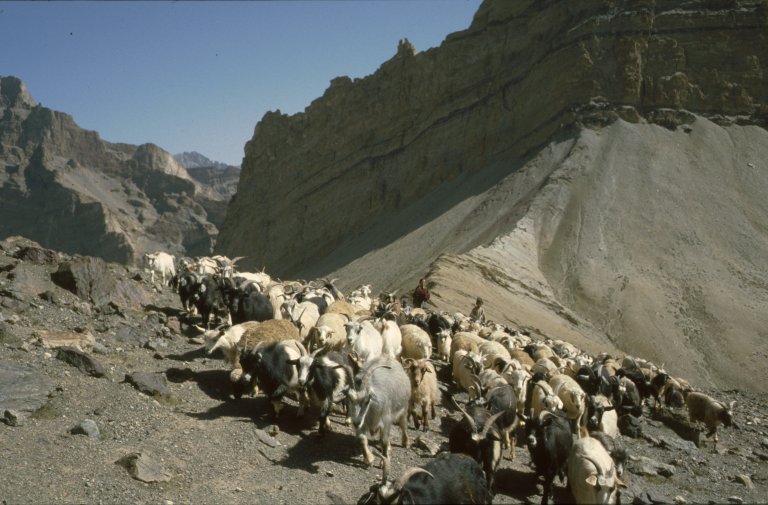
There was a long, steep climb to the first high pass, Shirshi-la. The views of the river below and the mountains around were fantastic, more than a good excuse often to pause and gather strength. The air is so thin at that altitude that each step took a great effort. I felt as if I were being pulled back down. There were the mandatory prayer flags at the pass, the sight of which we relished each time because it also meant that we had reached the pass.
One older Ladakhi man who asked us for medicine for his eyes, since he could barely see (protection against the sun’s rays at that altitude is a must), but we could do nothing for him.

Another man stopped at our tents one night, we gave him a postcard from our city that also had pictures of cars. He asked his companion what the cars were, since he had never ventured out of the mountains and had never seen one before.

We had a tent, but there was a hotel at our stop on the 4th night:

On the trail: Raftan, Dave and me

At the highest pass, Singa-la at 5,120 meters, we crossed the border between Ladakh and the Zanskar. Raftan was happier than we to reach the pass, because he came from Zanskar and this was his last trip of the season. He went up to the prayer flags on the chortens and—to our great surprise—ripped off four different colors, which he tied together and presented us.

Halfway, we arrived at the large Linshed Monastery filled with many monks. They invited us to observe them praying and gave us some tsampa, roasted barley meal, with butter tea to eat. It is really not my cup of tea, so to say, but if you finish what they give you out of politeness, they immediately give you more. We let some look through our camera with zoom lens, and they were ecstatic when we zoomed the lens and could hardly believe what they saw.

Linshed Monastery
A group of French trekkers bargaining for trinkets:

Making butter for butter tea to mix with tsampa:

Mealtime:

Local guy traveling through the area:
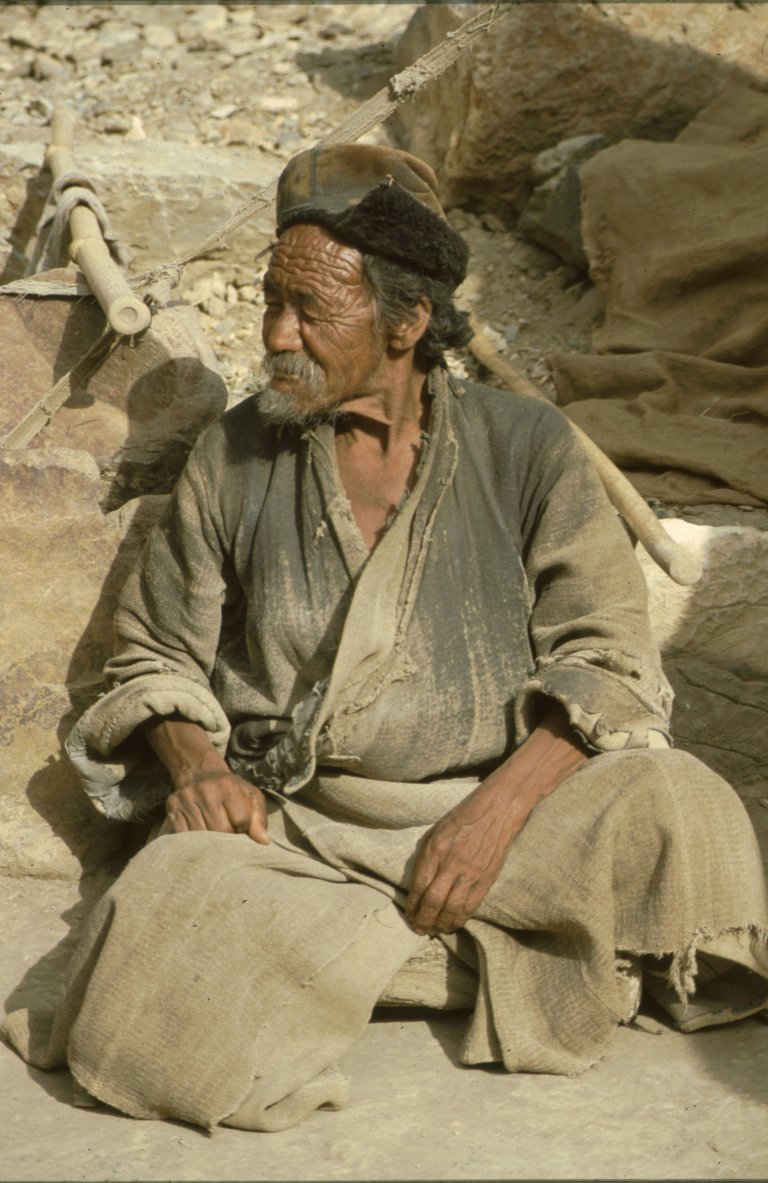
I remember lying outside my tent that night, looking up at the many stars (the air is so dry and the altitude to high that you see many) and the huge monastery, thinking how lucky I was to experience this and had to come back some day, which I never did. There was total silence, since there was no electricity and no roads or vehicles within miles. The monks were apparently asleep or meditating, because no sound came from the monastery either. I was tempted to stay awake all night and stare at the amazing sights, but I knew that sleep was necessary for the next day’s hike. I close my eyes for a while, but only slept for short intervals, frequently waking to gaze around. Several dogs were prowling around and barking, and once I woke up to find one lying next to me.
View down the valley and the next morning:
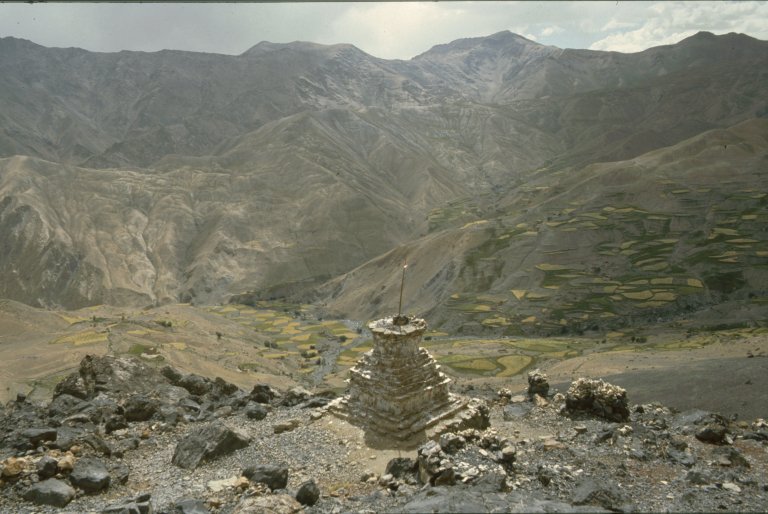

The valley gradually became wider and the scenery changed less. The average altitude of the Zanskar Valley is 4,000 meters, but it was easier walking, since there were no more ascents or passes. We set up our tent in a huge field near Zanskar River below the village of Pishu. Some small children were watching over some sheep and goats and making a game of catching donkeys and riding them. They led a couple of donkeys over for us to ride, but we did not get too far until we fell off.
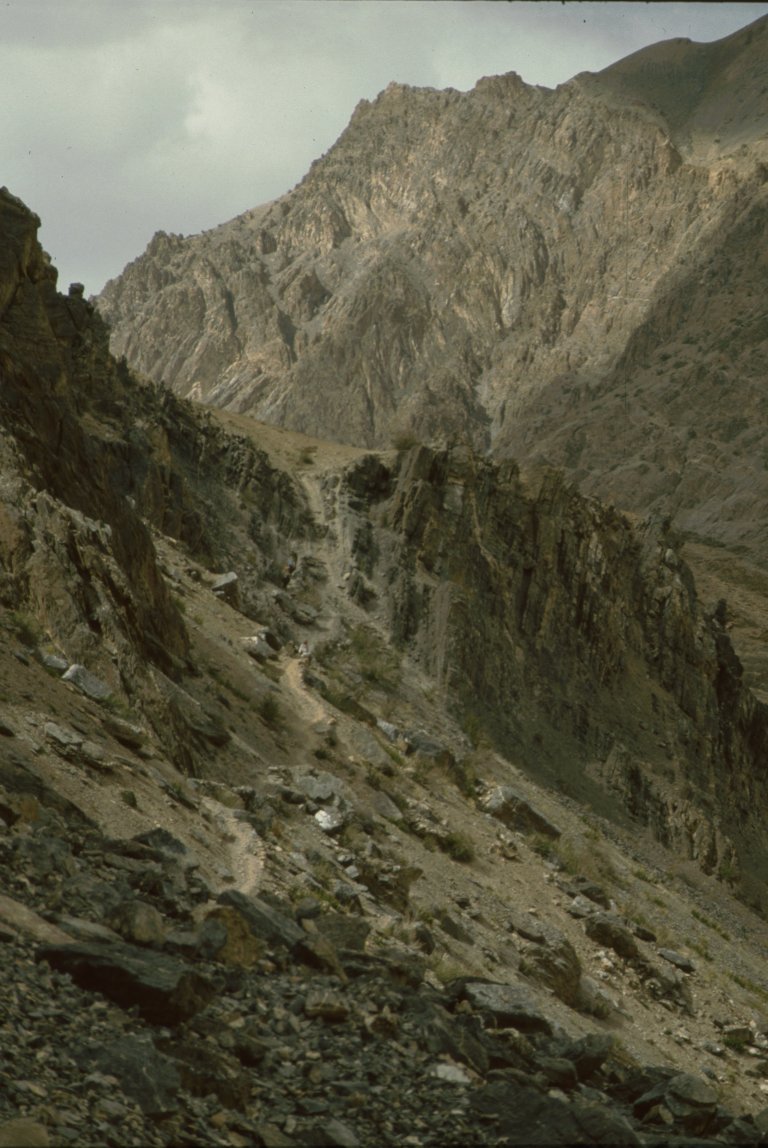

Raftan left us for the night to go across the river to his family in Zangla. Zangla is actually a kingdom in itself and has its own king. The literature we had read about it said it was nothing special, so we declined to accompany him and instead did some washing and relaxing. However, we did walk to the infamous rope bridge spanning the Zanskar River and connecting Zangla to Pishu. It is 70 meters long and although the woven rope had been reinforced with a couple of steel cables, it still appeared to be a flimsy construction. The swift current of the river creates a strong wind that sways the ropes back and forth. There is one rope to walk on, and one on each side to hold on to. The locals usually glide across, but stories of people slipping and being carried to certain deaths in the river’s freezing waters are not uncommon.
Mechtild trying out the rope bridge


We walked a few feet out onto the rope bridge. It was a strange feeling looking down at the gushing water with the wind blowing full blast. After I convinced myself that I could make it if need be, I returned to the shore. Certainly, it would have been a cheap thrill to cross it, but I gave up cheap thrills with adolescence. Staring at the river, I did not doubt that I did not want to test its strength.
The lack of the change of scenery made the hike seem longer the next day. Once in a while, thick black clouds would pass overhead, and their shadows—which we could follow for miles—changed the tone of the landscape.
We arrived in the later afternoon at Karsha, the second largest village in Zanskar. It is considered the real capital or center of Zanskar by many, and anyone who has been to Karsha and Padum (the actual capital) knows why. The Karsha Monastery is large and beautifully situated above the village on the side of a mountain. It housed approx. 150 monks at the time. The head abbot was reputed to be the younger brother of the Dalai Lama. He married, which should have disqualified him, but nobody claimed that he was no longer the abbot.
Karsha Monastery above the village

Padum, within view across the river, is more like a bus station in some run-down city with all its disadvantages and nothing to the contrary.
Karsha had approx. 70 houses, a school, a medical aid station, a center for animal breeding and almost a small hotel. The monks were in the process of building the hotel, although they seemed resigned to the fact that they would not finish it that season. Only two rooms had been completed, and one was already rented. We just managed to squeeze four cots into the other.
There was, however, one very unfortunate omission in the hotel; there was no toilet. This can be quite a problem in a landscape where there is very little vegetation behind which one might seek some privacy. Other tourists had been brazen and sufficiently impolite to use the unfinished hotel rooms for this purpose, but we trudged a ways to some ruins on a hill and squatted behind large boulders.
After depositing our packs at the hotel and ordering dinner, we climbed up to the monastery. The monks were really friendly and did not even want an entrance fee, which we would have gladly given. We watched them making a mandala as we had in Spitok Monastery near Leh. One of the monks was making a sculpture out of butter and tsampa.
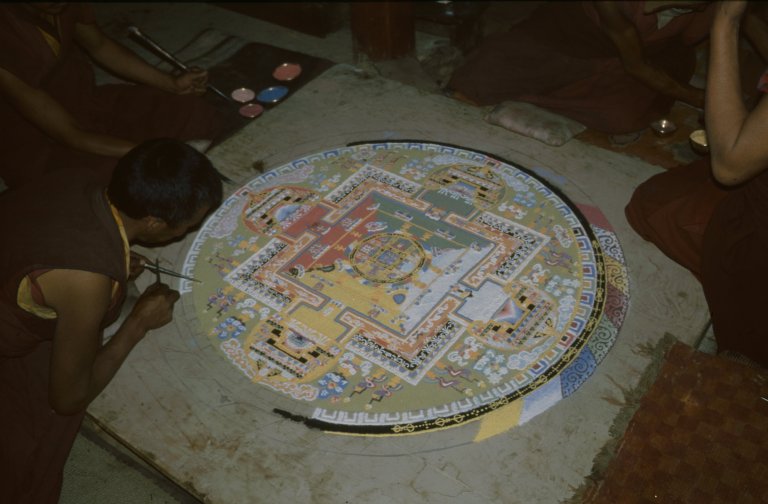

While we were eating dinner, a light flickered on for about 10 seconds and then went out. The monks clapped their hands joyfully; Karsha had just received electricity that day!
We would have loved to continue a second 10 days to norther India, but our vacation was nearing an end and we had to go to Padum and take a whole-day bus trip for the 40 kilometers back to the main road and the town of Kargil where we were able to get a bus back to Srinigar and our flight.
We had to get to Kargil, but there were many foreigners in Padum who had been waiting for days for the same transport. There had been some landslides and the road—if it might be called such—was blocked. Our hotel owner claimed there would be a truck the next day, and three French tourists thought there would be a bus. Nobody knew for sure. We talked to a lot of other tourists; there were approx. 15 waiting there, and they were all pretty desperate to get out. And some had flights even before us from Kashmir and Delhi.
That evening we struck up a conversation with a truck driver. We asked him when he thought a bus would arrive, and he reckoned in two days. He told us that it was forbidden for truck drivers to take passengers, because of the danger of accidents. And, indeed, several days before four foreigners had been injured—three of them badly—when the truck they were riding in to Padum toppled off the road. The laws were enforced more strictly after such incidents, i.e., the bribes the drivers paid if caught were higher.
He was a Muslim from Kashmir and drove supplies to Padum twice a month in the summer. In the winter, he drove all over India. He would have preferred to do the latter in the summer too, but he had to go where his boss sent him. He was happy for someone’s company and invited us into his cab to share his rum.
A friend of his came by, and we were afraid we had insulted him that afternoon by our laughing. The man was dressed in a pin-striped suit with dark sunglasses and a wide-brimmed hat. He looked like a stereotype of a Sicilian mafioso. Fortunately, he had not taken offense and was quite friendly, making us feel ashamed for our afternoon’s behavior. I realized that many Westerners who wear dress native must appear just as ludicrous to the local people.

After two days and as I was despairing, I heard two tourists outside negotiating with the owner for a room. They had arrived in a bus. Within minutes, a caravan of tourists was rushing to buy bus tickets. The friendly truck driver told us to hurry, but that was easier said than done. There was such much pushing and shoving at the “ticket office”, the back room of the one of the restaurants, that I could not get close to buying one. The truck driver recognized my dilemma and came it and got them for me.
The bus the next day was very full and uncomfortable. It was a sharp contrast to our days of hiking, but we had no choice. We stopped that night at Yuldo, the last Buddhist town and the religious border. We boarded the bus reluctantly the next day, but it was forced to stop after a couple of hours due to a landslide. Although it was not serious, it foretold of worse things to come.
Around noon, the bus had to stop because of a bigger landslide. We could also see a few more not far ahead, prompting the bus driver to say that was as far as they were going that day. However, there was a village, Panikar, not far away where there is daily bus service to Kargil. We had the option of either walking 24 kilometers to Panikar along the road or 10 kilometers over a mountain. Of course, we could have waited until the next day when we were assured that the road would be cleared, which is what all the locals on the bus planned to do. But the foreign community was unanimous in its decision to proceed on foot.
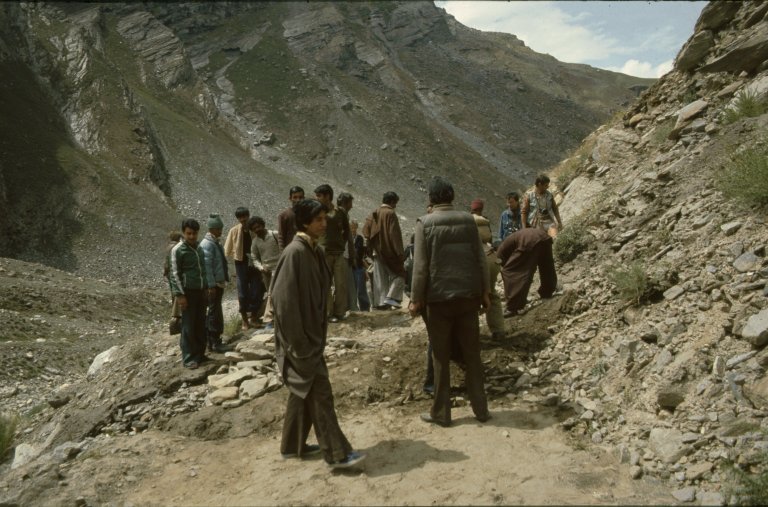
We decided to go over the mountain. Not only was it much shorter, but we also hoped to catch sight of Kun and Nun, the area’s two highest mountains at 7,077 and 7,555 meters respectively. They were hidden by clouds when we started the ascent, but we occasionally caught glimpses of them when the clouds swept by.
We finally arrived in Panikar after six hours of hiking with full packs, arranged for a room and ordered dinner, but then the bus we had been on arrived one minute later. We were lucky that our dinner order had not registered, and all the foreigners quickly deserted the hotel for the bus, much to the chagrin of the hotel owner who had been counting on the night’s receipts. The road was then paved, but it was still much farther than we had imagined. We arrived in Kargil after another five or six hours, totally exhausted, but happy in the knowledge that we would not miss our plane out of Srinigar several days later.
The trek was not without its dangers. We passed a man going the other way slouched on a horse, who could only mutter that he was sick (and he looked terribly ill). Three Australians, whom we passed, told us that they had paid a horseman to carry their packs in advance, but he had disappeared when they woke up one morning, and they were having great difficulty carrying their gear and supplies. Three Germans going the other way asked us where they could get water; they had almost none, and their guide did not know the area well enough to have advised them about this beforehand nor did he know when they would be able to get some. There had been a poster in Leh asking for information about a young Frenchman who had disappeared on the trek, and a story about a few others who had slipped and fallen off a narrow path to their deaths.
We were alone most of the time trekking, although there certainly were many others on the trail at the same time. Some were very friendly such as a Dutch photographer, who even apologized for stopping the night as the same place as we, fearing that he was interfering with our false impression of being the only ones in that part of the world. Some people we met on the trail were friendly and some ignored us, pretending that we were not there and they were the sole trekkers exploring this part of the world. There were a couple of Italian and French groups on packaged trekking tours, one even consisting of 20 tourists, 40 horses and 10 Kashmiri guides.
I noticed that I have been writing in more detail the closer I come to the end of this description of our trip. I guess it is because it brought back so many fond memories of a great trip and I am loath to leave them. It was my first of several treks in the Himalaya (in Nepal, Pakistan and Tibet), which were all great, but this one seemed the most magical.

Zanskar and the people haven’t changed (except that most of the asrea, but not all, has electricity) but you wouldn’t recognize Leh today. Another great story.
LikeLike
Thanks! I thought for a long time that I would have to return to Linshed Monastery on the trek to Zanskar, it was such a magical place. But then maybe I would just be disappointed. I imagine Leh has changed a lot and have even heard that Amazon is delivering there.
LikeLike
The monasterues in Zanskar probably haven’t changed a lot. We trekked to Phugtal monastry from Paddum and it was very remote, the monks were very kind and the student monks were so happy to entertain us. We didn’t go to Linshed though.
LikeLike
Have to check where roads have been built.
LikeLike
Not many places😊
LikeLike
Amazing report!,
LikeLike
What a beautiful account of your trip!
LikeLike
Thank you very much!
LikeLike